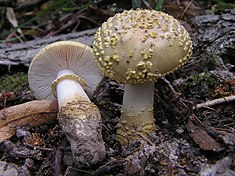Amanita franchetii
| Amanita franchetii | |
|---|---|

| |
| European Amanita franchetii (Boud.) Fayod, Craula, Hörselberg-Hainich, Thüringia, Germany | |
| Scientific classification | |
| Kingdom: | |
| Division: | |
| Class: | |
| Order: | |
| Family: | |
| Genus: | |
| Species: | A. franchetii
|
| Binomial name | |
| Amanita franchetii | |
| Varieties | |
|
A. franchetii (Boud.) Fayod var. franchetii | |
| Synonyms | |
|
Amanita aspera var. franchetii Boud. | |
Amanita franchetii is a species of fungus in the Amanitaceae family. It was given its current name by Swiss mycologist Victor Fayod in 1889 in honor of French botanist Adrien René Franchet.[1] A. franchetii occurs in Europe and North Africa with oaks (Quercus ssp.), chestnuts (Castanea ssp.), and pines (Pinus ssp.).[2]

A similar fungus in western North America was also referred to as A. franchetii, but was long suspected of being a separate, undescribed species,[2] and in 2013 was formally described under the name Amanita augusta.[3]
Amanita aspera and Amanita franchetii are synonyms.[4]
There also exists a variety known as Amanita franchetii var. lactella that is entirely white except for the bright yellow universal veil remnants.[5] It is found in the western Mediterranean region, associated with several species of oak (Quercus suber and Q. robur) and hornbeam (Carpinus betulus),[5] and is also reported from Serbia.[6]
Edibility
Amanita franchetii's edibility is suspect; it should not be taken for the table.[7] Although chemical analysis has not thus far revealed in A. franchetii the presence of the amatoxins found in some other Amanitas,[7][8] it has recently been implicated in the deaths of ten people in China who displayed symptoms similar to those caused by amatoxin poisoning.[8]
| Amanita franchetii | |
|---|---|
| Gills on hymenium | |
| Cap is flat or convex | |
| Hymenium is free | |
| Stipe has a ring and volva | |
| Spore print is white | |
| Ecology is mycorrhizal | |
| Edibility is not recommended | |
See also
References
- ^ Fayod MV. (1889). "Prodrome d'une histoire naturelle des Agaricinés". Annales des Sciences Naturelles, Botanique (in French). 9 (VII): 181–411.
- ^ a b Tulloss, R.E. (2011). "Amanita franchetii". Amanitaceae studies. Retrieved 8 November 2011.
{{cite web}}: Unknown parameter|editors=ignored (|editor=suggested) (help) - ^ Bojantchev D, Davis RM. (2013.) Amanita augusta, a new species from California and the Pacific Northwest. Archived 2013-05-02 at the Wayback Machine North American Fungi 8(5):1-11. doi:10.2509/naf2013.008.005
- ^ Kuo, M. (March 2005). "Amanita franchetii". MushroomExpert.Com. Retrieved 8 November 2011.
- ^ a b Tulloss, R.E. (2011). "Amanita franchetii var. lactella". Amanitaceae studies. Retrieved 7 January 2013.
{{cite web}}: Unknown parameter|editors=ignored (|editor=suggested) (help) - ^ Lukić N. (2008). "The Distribution and Diversity of Amanita Genus in Central Serbia" (PDF). Kragujevac Journal of Science. 30: 105–115.
- ^ a b Arora, David (1986). Mushrooms demystified : a comprehensive guide to the fleshy fungi (2nd ed.). Berkeley: Ten Speed Press. p. 278. ISBN 9780898151695.
- ^ a b Huang, L.; Liu, X. L.; Cao, C. S.; Ying, Q. (22 February 2009). "Outbreak of fatal mushroom poisoning with Amanita franchetii and Ramaria rufescens". Case Reports. 2009 (feb22 1): bcr0620080327–bcr0620080327. doi:10.1136/bcr.06.2008.0327. PMC 3029993.
External links
- Amanita franchetii in Index Fungorum
- "Amanita franchetii". Mykoweb. Archived from the original on 2011-08-05. Retrieved 2011-11-08.
{{cite web}}: Unknown parameter|dead-url=ignored (|url-status=suggested) (help) - A description of the western North American species. - Amanita franchetii var. lactella photo, from Aranzadi Society of Sciences, Mycology Gallery.

